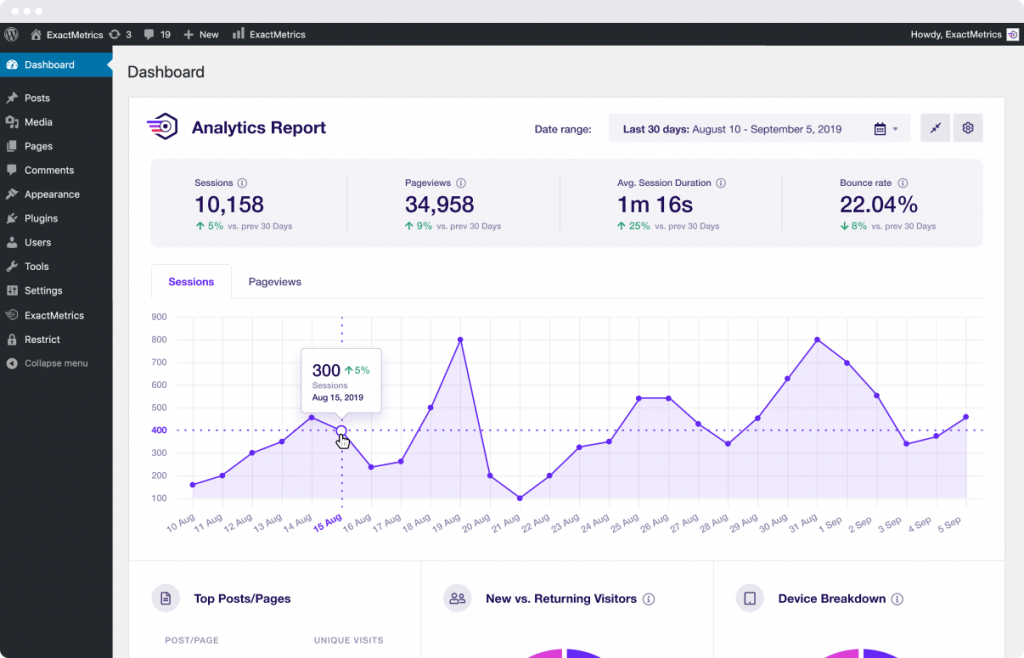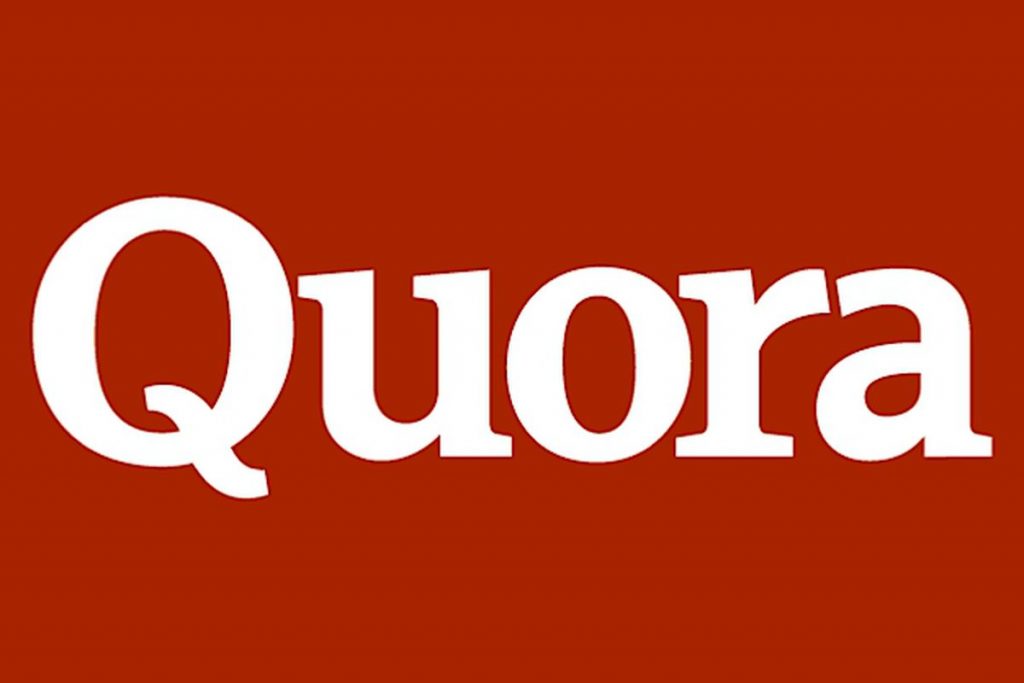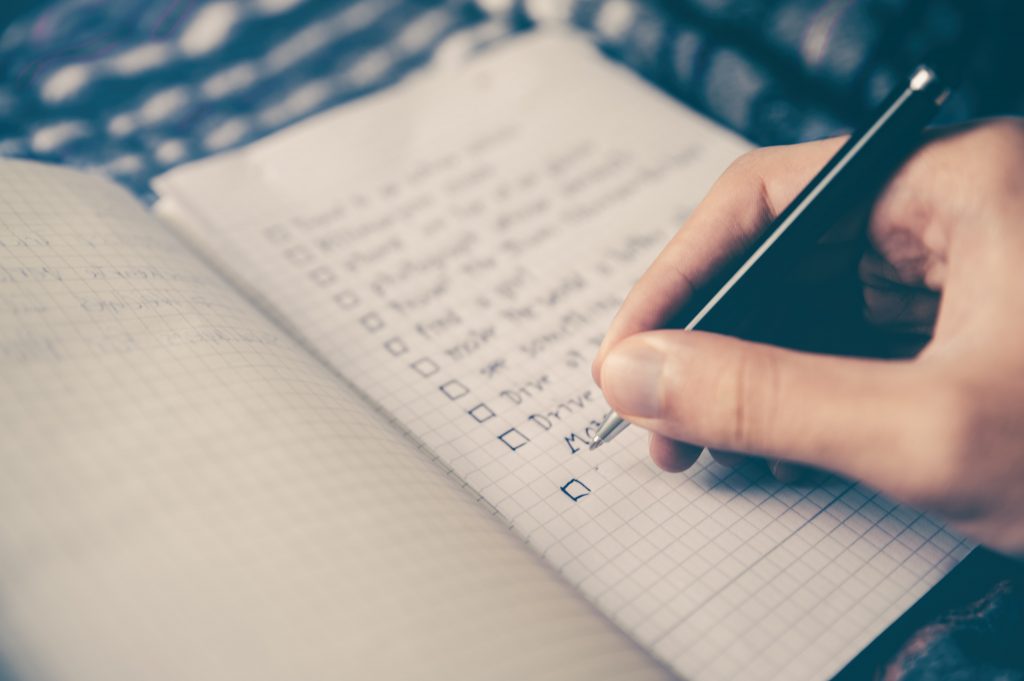So, in order to succeed at blogging, you need to know how to write amazing blog posts that people will actually want to read!
You want more readers for a couple of reasons.
First, more readers are more eyeballs on your content.
This is a metric that you can easily measure and set targets for. I like to use a plugin to put the traffic stats right on my WordPress Dashboard when I log in so I can get a quick visual of how many people are coming to my site and which pages they are coming in from.
Second, you want to write extraordinary blog posts so you get engaged viewers who become passionate about your articles and your content.
The more engaged somebody is with your content, the more likely they are to take action on what you suggest. That could just mean an avid fan, or it could mean somebody taking action and purchasing an affiliate product through your link or a product you've created yourself. It all depends on the article.

You measure traffic by users and page views, and session time (which is how long they were on your site for.) I recommend tracking your traffic stats using Google Analytics, and the Lara Google Analytics plugin which is free to start.
So… how on Earth do you come up with ideas for blog posts that people will actually want to read?
4 Ways To Find Fantastic Ideas For Blog Posts
Keyword Research For Blog Posts
First, start with a free tool like UberSuggest (created by Neil Patel) or Keywordtool.io to lookup keyword terms in your niche that people are searching Google for.
These tools show you how many searches that keyword term is getting per month, and how easy or difficult it is to rank on the first page of Google for that term.
You simply type a broad keyword into the tool and it returns the most popular auto-suggest keywords back to you. (Auto-suggest is like how Google tries to predict what you are typing into the search box. Try it out and go through a few letters of the alphabet and see how many you didn't even think would be a viable search term!)
Free Keyword Tool Chome Extention
I also would recommend installing a Chome Extention called WMS Everywhere.
It adds the search volume and CPC data for the keyword you searched for and the most relevant related searches to the one you just made. It adds this data to the sidebar of your Google Search. It looks like this:

Note: When using keyword tools, you want to find keyword terms that have a high search volume and low competition – these are the ones you want to write a blog post about as it will be easier to rank in Google for the term which means more people will find your content.
Keep the blog post centered around one specific term that you select as much as possible.
When you are starting out, try to really find a search phrase with low competition. Once you see traffic coming organically from the search engines to your article, you will gain confidence, and you can slowly start tackling more competitive search phrases.
Become A Spy!
Next, make a list of successful bloggers in your niche. Once you have that, go to BuzzSumo to see what their most popular blog posts are. This is a powerful tool. Do a lot of research beforehand so you can get the most out of their free trial.
The Two Best Q&A Search Engines
Put on your thinking hat. Think about common problems or questions people have related to the topic you blog about, and then you can write blog posts that directly solve those problems and answer their questions. If you are having trouble, there are two “Q&A Search Engines” that can help.
Answerthepeople.com is a cool search engine that is based all around auto-suggest, LSI (latent semantic indexing which in laymen's terms means synonyms), and answering questions.

The other one is Quora which is kinda like a Reddit focused on questions. These can both give you great ideas. By the way, you can follow me on Quora from this page.
Pinterest Research
Lastly, go to Pinterest and search for topics and keyword terms related to your niche. Pinterest? Yeah, that Pinterest. Think of Pinterest as a VISUAL search engine. See which bloggers and blog posts are coming up at the top of the results and which Pinterest captioned pins spark your “Yeah, I ‘d read a blog post on that” niggle.
Keep track of your ideas for new Blog Posts in an Evernote document or a Google Sheet. (Both are free!)
So now that you've got a bunch of ideas and can't want to start creating content…
How do you actually WRITE a Blog Post?
It's easier than you think.
First, decide if you like ambient noise or silence.

If you like Ambient noise, check out the Spotify playlist Coffee Shop Background Noise, or I like the Lo-Fi Beats playlist. I'm serious, I really like these playlists and they help put me in the right frame of mind.
Sometimes I like the silence of my Bose Noise-Cancelling Headphones not plugged in. (Yeah, weird, I know.). They are super comfortable and feel like a little hug around your head. So nice!
The Headline
Start your post off with an attention-grabbing title that serves two purposes: it has to make people want to click through and read it (like a Headline) and it should also have your exact keyword phrase at least once near the beginning of the title.
Think of the headline as a Cosmo Headline.

You need a little salaciousness and some sizzle. Make sure your article covers what you promise, but you want to sell it a little bit. Boring doesn't work on the internet. (That's why there are so many click-bait headlines on so many sites.)
The thing people don't understand about blogging is that a long article is composed of short sections with short sentences. Goodbye grammar you learned in College! Hello, easy-breezy writing style.
You don't want to write a giant wall of text. It's hard to read and will turn people off quickly. Use headings, short paragraphs, images, and bullet points to break up the text and make it easy to read.
Bullets. Even one-word sentences are okay. Sometimes.
Write a minimum of 1,000 words… but try to go even longer! Studies have shown that most blog posts that rank on the first page of Google for a specific search term are at least 2,500 words long.
(Remember, you don't need to write it in one sitting!)
Again, not every post is going to be that long, but if you have more to say, go for it. The great thing about a blog is that it's easy to save a draft, take a few minutes for a cup of tea and come back and see what else you can add to your post.
There are 5 Tried-And-True templates for your blog posts
1. The Pillar Post
This is one of the most important types of blog posts you can have.
A pillar post (which references the pillars that hold up an old ancient Greek building) is an in-depth, highly detailed blog post related to the topic of your blog. It’s also known as “cornerstone content” for your blog.

This is what you would want somebody to read first if they landed on your blog and you wanted to make a good impression. Aim to be the most definitive, thorough post on the topic you can think of.
Examples of pillar posts:
- The Ultimate Guide to Backing Up Your Digital Photos (tech blog)
- How To Live In Cambodia for $30 a Day (travel blog)
- How to Start a Digital Marketing Agency Business (marketing blog)
- The Ultimate Guide to Homeschooling Your Kids (homeschool blog)
It goes without saying that pillar posts should be highly related to your blog niche. Try to make your pillar content as relevant, helpful, and detailed as possible, and link to these posts often in your other blog posts. (Linking to your other posts from your pillar post and vice versa is a great SEO signal to Google that your blog is an authority on a particular topic.
Speaking of linking in general, don't be afraid to link out to other articles. Google sees that as being a “good neighbour” rather than somebody who is trying to be a link hoarder.
2. The Tips and Tricks Post
Think of that Cosmo magazine again. They often have tip headlines related to sex. Sharing tips and tricks is a great way to provide value and create blog posts that will be really popular.

Tips, especially if they are quantified with a number, like “5 ways to…”
Create a desire to read the post to see if you can find some hidden knowledge. It engages and grabs your reader using basic, undeniable human psychology.
The goal is to share “quick wins” with your visitors that they can implement easily to achieve their desired results.
These can be shorter, and can even be incomplete. Just give them something memorable and engaging to read about and they will want to read more from you.
Examples of tips and tricks posts:
- 10 Tips for a Stress-Free Day at The Dental Office
- The One Secret Productivity Hack Secret From Steve Jobs
- 7 Strategies for Growing Your Blog Traffic
- 10 Things You Should Never Buy at Costco
3. The List Post
A list post is exactly what it sounds like! A big list of ideas, habits, or tips.

Everyone likes list posts because of their perceived value. They put a bunch of great ideas into one place, which is super convenient. This type of blog post is also popular being shared on social media – especially if it is (or seems) definitive
Examples of list posts:
- 9 Ways To Make Money Passively
- 3 Sites To Download Royalty-Free Images
- 7 Habits of Wealthy Individuals
- 25 Indoor activities that cost nothing for PA Days
4. The “How To” Post
“How To” guides and tutorials work because they help your visitor solve a problem or maybe to learn something new.
How many times you’ve Googled or searched on YouTube for “how to do” something in the last month?
Well, there are other people who are searching right at this very moment, and you can help them by writing a really great “how-to” post to solve their problem.
Examples of how–to posts:
- How I Got Created 3 New Passive Income Streams in 60 days
- How to Turf your Basement and Turn It Into The Ultimate Soccer Playground for Your Little Soccer Star
- How to Self Publish Your First Podcast
5. The Round-Up Post
Round-up posts are blog posts where you round up a bunch of related content and put it all in one place.
You could round up your favorite tools and resources. I like to think of this as a review of multiple products, like a Round -Up of the top WordPress Page Builders, or a Round-Up of the Top Credit Cards for Small Business Owners.
You can really have fun with this and let it fly.
Examples of round-up posts:
- Top WordPress Page Builders: Round-Up!
- 10 Best Tools for Creating Graphics on Your iPhone
- 25 DIY Office Hacks on a Budget
6. The Interview Post
You can interview somebody in your industry and clean up and publish the transcript on your blog.
This creates a ton of great content and requires very little actual writing. If you recorded the interview, you can also publish a .mp3 audio for your visitors to download or listen to on your site. You can embed this directly into WordPress now without even having to add a plugin. It's easy! Just upload the .MP3 file to your media inside your post.
By the way, if you want to record a split-screen interview on Skype, this is the best way to do it!
Examples of interview posts:
- Interview with Molly Jenkins Instagram Expert
- How Tim Ferriss Structures His Day
- Pinterest Tips from Jane Smith
So What's Next?
A lot of new bloggers wonder how frequently they should be blogging. Great question. The answer is – as much as you can commit to!
It's better to be consistent than sporadic and unpredictable.
Make the choice to publish one amazing, in-depth, value-packed blog post per month vs publishing multiple short, sloppy blog posts every week. Never ever sacrifice quality for quantity with your blog posts.
Commit to a schedule (ex. one new blog post a week/every two weeks/every month) and stick to it for at least your first year as a blogger.

Write down what you're going to commit to. Like actually write it down now…
That's it, now start typing.
Want the blog post writing cheat sheet? Download it from this link.
Hey, I'm Andrew. I moved to Lisbon, Portugal from Canada. Follow my journey here.
I also happen to run a SAAS that helps marketers give their shared links superpowers. You can create a free account and start being more productive: Check out Linkalytics here.
I'm passionate about AI and using AI tools to help creators and marketers create better content, faster. Get the jump on AI and discover free AI tools every week.
Read my writings on Medium.
Got a marketing question? Need some direction? Book a call with me.

